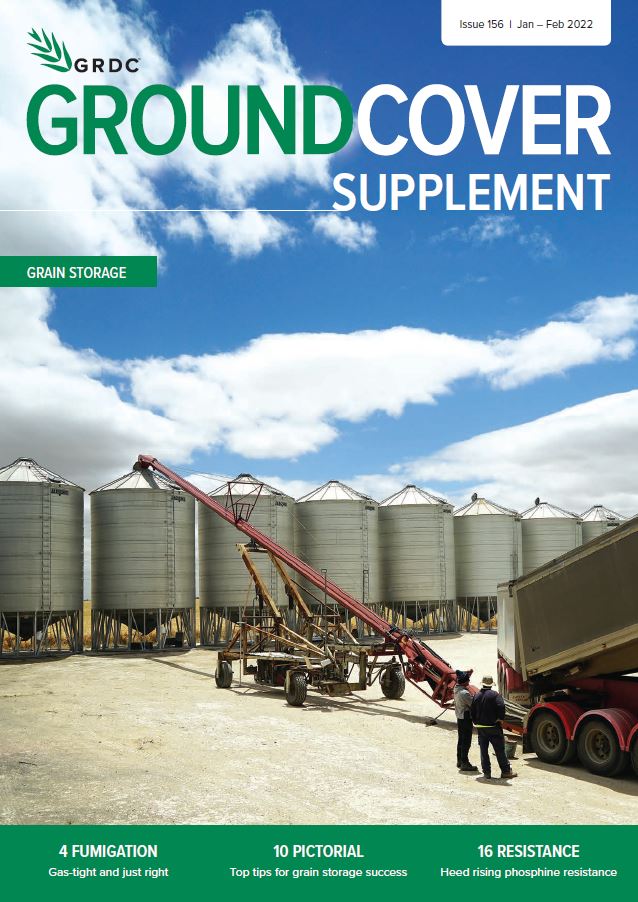This page shows the articles in of GroundCover.
GroundCover is also distributed every two months via mail. If you would like to subscribe to receive the hardcopy magazine, visit our subscription page.
Download supplement-

Getting the most out of ground-level fumigation
Supplement: Grain Storage, January-February 2022 - 15 02 2022Phosphine fumigation can now be completed using ground-level application systems, which are much safer for the user, but only if the appropriate safety precautions are taken. These include recirculation, space for liberation, condensation trap and safety systems for power outage.
-

Local study breathes fresh air into grain aeration
Supplement: Grain Storage, January-February 2022 - 12 02 2022Grain aeration is an important tool to protect to stored grain from deterioration and insect pests. New work is set to update the information currently used to determine aeration flow rates, which is outdated and not necessarily relevant to Australian conditions.
-

Successful fumigation: gas-tight and just right
Supplement: Grain Storage, January-February 2022 - 11 02 2022Getting phosphine fumigation right the first time not only disinfests grain, but it also protects the future use of phosphine by preventing the development of resistance in stored grain insect pests. There are a few simple steps to ensure effective fumigation every time.
-

When to open sealed silos
Supplement: Grain Storage, January-February 2022 - 06 02 2022Sealing a silo for long periods increases risks of grain degradation and silo damage. Silo seals are only designed to keep fumigant in the silo during fumigation. So, what should be done with gas-tight sealable silos when they are not under fumigation?
-

Phosphine curbs cowpea weevils in stored pulses
Supplement: Grain Storage, January-February 2022 - 05 02 2022While much is known about controlling stored insect pests in cereals, pests of pulses – such as the cowpea weevil or bruchids – have had little research to date. A new study is shedding light on the efficacy of phosphine control of these pests in mungbeans and chickpeas.
-

How good are stored grain protectants?
Supplement: Grain Storage, January-February 2022 - 04 02 2022Resistance monitoring of key insect pests has reaffirmed the value of using combined grain protectant treatments to overcome multiple resistances. Individual treatments are still effective in managing some species.
-

Sulfuryl fluoride can break phosphine resistance
Supplement: Grain Storage, January-February 2022 - 03 02 2022Rotating phosphine fumigation with sulfuryl fluoride is a valuable way to reduce the potential for development of phosphine resistance in grain storage insect pests, despite the need to hire a licenced fumigator.
-

Probing phosphine resistance in rusty grain beetles
Supplement: Grain Storage, January-February 2022 - 31 01 2022Resistance to phosphine fumigants in rusty grain beetle has increased substantially since the first resistant population was discovered in 2007. Resistant populations are now found across the full spectrum of the grain supply chain proving a real challenge for grain storage.
-

Today’s grain storage investments support tomorrow’s world
Supplement: Grain Storage, January-February 2022 - 30 01 2022GRDC’s investment in ‘On-farm Grain Storage – Development’ has helped growers double the volume of on-farm grain storage in the past 10 years. These changes have provided improved opportunities for growers to pursue more profitable market opportunities and enhance harvest logistics.
-

Meet the dedicated team improving on-farm grain storage
Supplement: Grain Storage, January-February 2022 - 29 01 2022Not every grower is able to buy new storage, but through GRDC’s ‘Grain Storage Extension Project’, every grower has access to information to help them select and effectively utilise the most appropriate storage options for their business.


























































